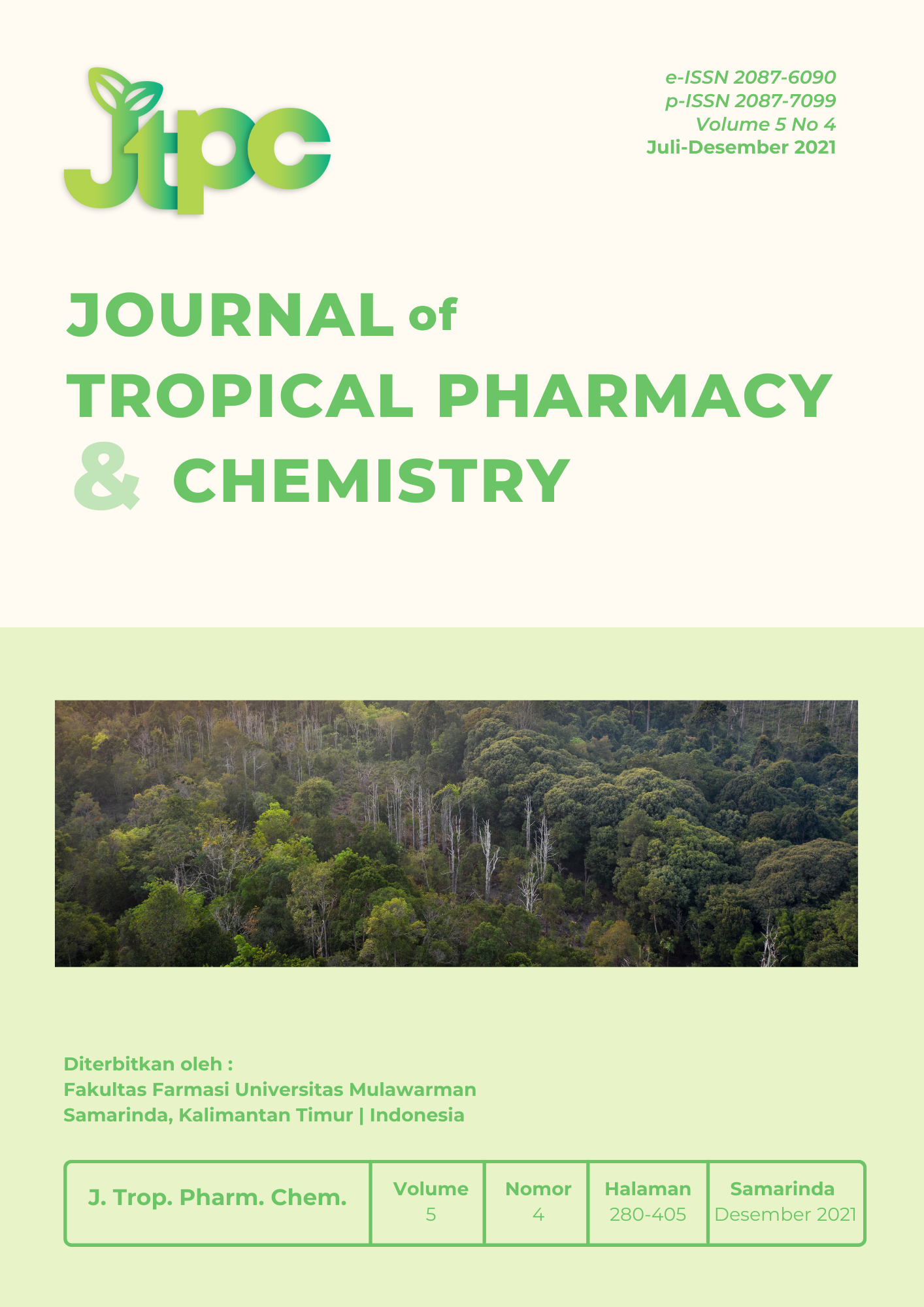Analysis of SARS-CoV-2 Spike Protein as The Key Target in the Development of Antiviral Candidates for COVID-19 through Computational Study
DOI:
https://doi.org/10.30872/j.trop.pharm.chem.v5i4.257Keywords:
spike protein, coronavirus, ACE-2, COVID-19, computational studiesAbstract
The recent public health crisis is threatening the world with the emergence of the spread of the new coronavirus 2019 (2019-nCoV) or severe acute respiratory syndrome coronavirus 2 (SARS-CoV-2). This virus originates from bats and is transmitted to humans through unknown intermediate animals in Wuhan, China in December 2019. Advances in technology have opened opportunities to find candidates for natural compounds capable of preventing and controlling COVID-19 infection through inhibition of spike proteins of SARS-CoV-2. This research aims to identify, evaluate, and explore the structure of spike protein macromolecules from three coronaviruses (SARS-CoV, MERS-CoV, and SARS-CoV-2) and their effects on Angiotensin-Converting Enzyme 2 (ACE-2) using computational studies. Based on the identification of the three spike protein macromolecules, it was found that there was a similarity between the active binding sites of ACE-2. These observations were then confirmed using a protein-docking simulation to observe the interaction of the protein spike to the active site of ACE-2. SARS-COV-2 spike protein has the strongest bond to ACE-2, with an ACE score of ?1341.85 kJ/mol. Therefore, some of this information from the results of this research can be used as a reference in the development of competitive inhibitor candidates for SARS-CoV-2 spike proteins for the treatment of COVID-19 infectious diseases.
Downloads
References
[1] Wang C, Horby PW, Hayden FG, Gao, GF, 2020. A novel coronavirus outbreak of global health concern, Lancet, 395, (10223), 470-473.
[2] Richman DD, Whitley RJ, Hayden FG, 2016. Clinical Virology, 4th ed, Washington: ASM Press.
[3] Huang C, Wang Y, Li X, Ren L, Zhao J, Hu Y, et al, 2020. Clinical features of patients infected with 2019 novel coronavirus in Wuhan, China, Lancet, 395, (10223), 497-506.
[4] Rothe C, Schunk M, Sothmann P, Bretzel G, Froeschl G, Wallrauch C, et al, 2020. Transmission of 2019-nCoV infection from an asymptomatic contact in Germany, The New England Journal of Medicine, 382, (10), 970-971.
[5] Li Q, Guan X, Wu P, Wang X, Zhou L, Tong Y, et al, 2020. Early transmission dynamics in Wuhan, China, of novel coronavirus-infected pneumonia, The New England Journal of Medicine, 382, (13), 1199-1207.
[6] Heymann DL, 2020. Data sharing and outbreaks: Best practice exemplified, Lancet, 395, (10223), 469-470.
[7] Liu X, Wang XJ, 2020. Potential inhibitors for 2019-nCoV coronavirus M protease from clinically approved medicines, Journal of Genetics and Genomics, 47, (2), 119-121.
[8] Zhou P, Yang XL, Wang XG, Hu B, Zhang L, Zhang W, et al, 2020. A pneumonia outbreak associated with a new coronavirus of probable bat origin, Nature, 579, 270-273.
[9] Lu R, Zhao X, Li J, Niu P, Yang B, Wu H, et al, 2020. Genomic characterisation and epidemiology of 2019 novel coronavirus: Implications for virus origins and receptor binding, Lancet, 6736, (10224), 1-10.
[10] Letko M, Munster V, 2020. Functional assessment of cell entry and receptor usage for lineage B ?-coronaviruses, including 2019-nCoV. Nature Microbiology, 5, 562-569.
[11] Hoffmann M, Kleine-Weber H, Kruger N, Muller M, Drosten C, Pohlmann S, 2020. The novel coronavirus 2019 (2019-nCoV) uses the SARS-coronavirus receptor ACE2 and the cellular protease TMPRSS2 for entry into target cells.
[12] Graham RL, Becker MM, Eckerle LD, Bolles M, Denison MR, Baric RS, 2020. A live, impaired-fidelity coronavirus vaccine protects in an aged, immunocompromised mouse model of lethal disease, Nature Medicine, 18, (12), 1820-1826.
[13] Ng OW, Chia A, Tan AT, Jadi RS, Leong HN, Bertoletti A, et al, 2016. Memory T cell responses targeting the SARS coronavirus persist up to 11 years post-infection, Vaccine, 34, (17), 2008-2014.
[14] Liu WJ, Zhao M, Liu K, Xu K, Wong G, Tan W, et al, 2017. T-cell immunity of SARS-CoV: Implications for vaccine development against MERS-CoV, Antiviral Research, 137, 82-92.
[15] Kumar S, Maurya VK, Prasad AK, Bhatt MLB, Saxena SK, 2020. Structural, glycosylation and antigenic variation between 2019 novel coronavirus (2019-nCoV) and SARS coronavirus (SARS-CoV), Virusdisease, 31, (3), 13-21.
[16] Walls AC, Xiong X, Park YJ, Tortorici MA, Snijder J, Quispe J, et al, 2019. Unexpected Receptor Functional Mimicry Elucidates Activation of Coronavirus Fusion, Cell, 176, (5), 1026-1039.
[17] Yuan Y, Cao D, Zhang Y, Ma J, Qi J, Wang Q, et al, 2017. Cryo-EM structures of MERS-CoV and SARS-CoV spike glycoproteins reveal the dynamic receptor binding domains, Nature Communications, 8, 15092.
[18] Walls AC, Park YJ, Tortorici MA, Wall A, McGuire AT, Veesler D, 2020. Structure, Function, and Antigenicity of the SARS-CoV-2 Spike Glycoprotein, Cell, 180, (2), 1-12.
[19] Dassault Systemes BIOVIA, Discovery Studio Modeling Environment, Release 2020, Dassault Systemes: San Diego, CA, USA.
[20] Meng EC, Pettersen EF, Couch GS, Huang CC, Ferrin TE, 2006. Tools for Integrated Sequence-Structure Analysis With UCSF Chimera, BMC Bioinformatics, 7, 339.
[21] Li F, Li W, Farzan M, Harrison SC, 2005. Structure of SARS Coronavirus Spike Receptor-Binding Domain Complexed With Receptor, Science, 309, (5742), 1864-1868.
[22] Prabhu DS, Rajeswari VD, 2016. In silico docking analysis of bioactive compounds from Chinese medicine Jinqi Jiangtang Tablet (JQJTT) using Patch Dock, Journal of Chemical and Pharmaceutical Research, 5, (8), 15-21.




